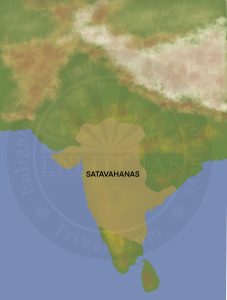Post Mauryan Period: Deccan Region
Satavahana
- The Satavahana dynasty ruled over a vast portion of the Indian subcontinent from the first century BCE to the second century CE.
- The Satavahanas are regarded as one of the most ancient historical dynasties in India’s Deccan area.
- Simuka founded the Satavahana dynasty.
- Satavahanas in the Deccan played a major role in the Mauryan administration. After Ashoka’s death, they declared complete independence.
- They were tremendously powerful and established their capital at Paithan or Pratisthan on the banks of the Godavari River.
- Important rulers include Hala, Gautamiputra Satakarni, and Vashishthiputra Pulumayi.
- The most well-known source regarding Gautami Putra Satkarni is the Nashik Prashasti inscription, which was engraved by his mother Gautami Balashri, and credits him with great military achievements.

Trade and Commerce
- The Satavahanas engaged in extensive trade with the Roman and Southeast Asian countries. Merchants formed guilds to expand their activities.
- Craft guilds were formed by artisans, including potters, weavers, and oil pressers.
- Silver coins called Karshapanas were used in trade.
- During the Satavahana period, there was an increase in overseas trade. Ptolemy lists multiple ports in the Deccan. Kalyani, located on the western Deccan, was the most important port for the Satavahanas. Gandakasela and Ganjam on the east coast were also prominent seaports.
- During their reign, the port town of Pratishthana (modern-day Paithan) was a major trading hub.
Art & Culture
- The Satavahana period saw the rise of art and architecture. Amaravati and Nagarjunakonda are well-known for their Buddhist stupa complexes with beautiful carvings.
- The dynasty also helped to build the Satavahana school of painting.
- Satavahanas performed Ashvamedha and Rajasuya sacrifices, as depicted in Nanaghat inscriptions.
- They worshipped Vasudeva, Indra, Surya, and Chandra.
- They provided land grants to Buddhists and Brahmins.
- The Nanaghat inscription mentions tax breaks for Buddhist monks who receive land grants.
- Satavahanas were succeeded by Pallavas of Kanchi, Chalukyas of Badami, and Pandyas of Madurai in the South, Vakatakas in Maharashtra and Berar region, and by Ikshavkus on the Eastern side of the peninsula in Krishna-Guntur region.
